
GET MOVING
SMALL DOSES DELIVER BIG PAYOFFS.
EXERCISE IS LIKELY already on your to-do list. And while it often seems impossible to squeeze such a good thing into a busy daily routine, it really is a crucial habit to adopt. Being active is what allows you to keep enjoying the wondrous pleasures of good food, and it gives you the energy to do the things you want to do, whether that’s playing with your kids or running a marathon.
The vital thing to remember when incorporating more physical activity into your life is that you don’t have to do it all at once. Breaking up exercise into 10-to 15-minute increments can yield health benefits and often makes getting 30 minutes a day more doable. And something is better than nothing. One study found that exercising for as little as 15 minutes a day can extend your life. When you’re starting out, do what you can and work exercise in when you can.
The payoffs are immense. In addition to helping you lose extra pounds and maintain a healthy weight, exercise helps you sleep, improves your mood, relieves stress, strengthens your immune system, and decreases your risk of virtually every ailment—from heart disease and diabetes to osteoporosis and cancer.
The ideal fitness plan includes cardiovascular exercise as well as muscle-strengthening exercise. This chapter is all about cardio—sustained, brisk physical activity that boosts your heart rate and accelerates your breathing.
Providing your body with the proper fuel before and after exercise is key. The right foods can keep you energized during your workout and help your muscles recover afterward.
If you’re not exercising much (or at all), your goal here is to be active for 30 minutes, three times a week—or the equivalent. If you’re at that level now, bump it up to five times per week or increase your intensity. Wherever you’re starting out, be sure to discuss your plans with your physician first.
YOUR GOAL
Be active for 30 minutes a day, three times a week.
The 12 Healthy Habits

WANT TO START AN EXERCISE ROUTINE but don’t know where to begin? You don’t need expensive exercise equipment for a super cardio workout. Here, the three ingredients that can get you started:
HEART RATE MONITOR
Use a heart rate monitor to keep track of exercise intensity. Our pick: Sportline’s DUO 1060 heart rate monitor ($119.99; sportline.com). The best heart rate monitors require you to wear a belt around your chest, but the DUO 1060 gives you the option of just placing your finger on the watch for an equally precise readout. What we really love is that it gives you that information in three beats or less, making it the fastest, most accurate contact heart-rate measuring device on the market.
FOOTWEAR
Invest in a pair of comfortable running shoes and reserve them just for exercise, like Asic’s GEL-Uptempo and GEL-Upshot ($85 each; asics.com). To be able to tackle any type of exercise, you need a training shoe that offers your feet stability from any angle, shock absorption from heel to toe, and a breathable mesh upper that lets your feet air out as you work out. Both the Uptempo and Upshot offer a superior mix of cushioning, traction, and support, all in a lightweight pair of shoes with a sock-like fit that almost makes you forget you’re wearing them.
HYDRATION
If you do more than an hour of cardio, you’re losing fluid and sweating out electrolytes like sodium and potassium.You don’t need to spend money on expensive, calorie-laden sports drinks. Water can do the trick, or try one of these five choices instead:
▪ Low-fat chocolate milk: Provides an ideal mix of carbs and proteins that tired muscles need for recovery.
▪ Iced green tea: Contains catechins that may help reduce muscle damage caused by exercise.
▪ Tart cherry juice: Full of anthocyanins that help decrease inflammation, oxidative stress, and muscle pain after exercise.
▪ Coconut water: Rich in potassium and helps rehydrate the body as effectively as a sports drink, although it’s lower in sodium.
▪ Tomato juice: Contains potassium and sodium to help replenish stores after sweating.
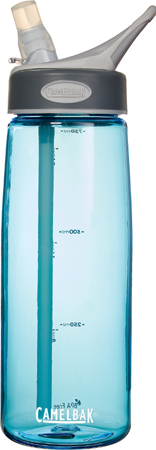

“I want to exercise—but injuries plague me.”
PHOEBE WU
Cooking Light Assistant Editor
 GET MOVING CHALLENGE: Even though she’s a spring chicken, Phoebe is thwarted by ankle aches and pains that come from a lifetime of playing sports like soccer and field hockey. “I’ve always done cardio, but lately the problem is that it hurts when I walk. If I do nothing, it will go away for a while, but as soon as I do something like running, it comes back immediately.”
GET MOVING CHALLENGE: Even though she’s a spring chicken, Phoebe is thwarted by ankle aches and pains that come from a lifetime of playing sports like soccer and field hockey. “I’ve always done cardio, but lately the problem is that it hurts when I walk. If I do nothing, it will go away for a while, but as soon as I do something like running, it comes back immediately.”
OUR ADVICE
▪ Consult a sports medicine physician. While a lot of people have a pain or injury that prevents them from exercising, ironically that pain can often be rectified—by exercise. In Phoebe’s case, she may just need a few sessions of physical therapy to give her ankle a boost.
▪ Mix up your cardio every few days. Each type of aerobic exercise trains different groups of muscles. If you keep exercising the same way every day, you can cause muscular imbalances that can pull your knees, lower back, and hips out of alignment (and create more unnecessary pain for yourself). Trying a new type of cardio at least every week (or even every time you exercise) will ensure you’ll hit every muscle group evenly.
▪ Consider a water workout. In the water, your body weighs 10% of what it does on land, which helps reduce the stress on your joints. If you can’t swim a stroke, simply tread water for one minute, rest for one minute, then repeat this cycle 8 to 10 times to start for a full-body cardio minus the aches and pains.
▪ Don’t be a weekend warrior. When you don’t have time to fit in a full workout during the week, it’s tempting to go double the distance on Saturday and Sunday. But don’t: You’ll most likely overdo it and reinjure yourself. Stick to a reasonable routine and try to sneak in an extra exercise session or two during the week if possible.
EXPERT TIP: Stay Hydrated

“Dehydration is one of the most common causes of fatigue during exercise. Hydrate before, during, and after workouts—the more you sweat, the more you need to drink. Choose sports drinks for hot conditions and endurance activities; otherwise, stick to plain old H20. Water flavored with thin slices of fresh citrus, cucumber, or melon is extra refreshing.”
—Dana Angelo White, MS, RD, certified athletic trainer and blogger, Healthy Eats
THERE’S NO NEED TO SPLURGE on an expensive gym membership; you can get in shape at home. These five pieces of equipment can be the basis of great workouts.
What is the one thing that would help you the most to be more active? Here’s what the Cooking Light community had to say.
42% Exercising with friends
29% More motivation
19% Time
7% Other (confidence, instruction, support from family)
3% Decreased pain
JUMP ROPE

Hop to it! Jumping rope is a great form of cardio that works virtually all your main muscles while improving your balance. If you haven’t tried it since elementary school, start with a two-to three-minute jumping session, then gradually add in extra minutes as you build up your stamina. A fifteen-minute skipping session will burn just over 200 calories.
HULA HOOP
It was all the rage in the 1950s, and now it’s making a comeback. A recent study sponsored by the American Council on Exercise found that 30 minutes of hooping burned around 210 calories—similar to the results you’d get in a kickboxing or step aerobics class.
STABILITY BALL

Instead of using a chair to watch TV, sit at your desk, or eat dinner with the family, try sitting on a stability ball. Researchers at the University of Buffalo found that people sitting on an exercise ball burned 4.1 calories more per hour (a 6% boost) compared to sitting in a regular office chair. Even though your body isn’t technically moving as you sit, using a ball forces your muscles to actively work—and burn calories—just to keep you balanced.

This device clips on your belt or waistband to count your steps or mileage. Just by wearing one you’ll end up more active—studies have shown that people who regularly wear a pedometer walk about a mile more each day. Already a walker? Consider investing in one anyway to log your times and distances to track your training. You’ll be inspired when you see improvements.
MP3 PLAYER
It’s an easy way to energize any sort of at-home workout, whether you’re running up and down your stairs or walking your favorite neighborhood route. Just make sure it’s upbeat or you’ll find yourself slowing down. And keep the volume low if you’re outdoors; you need to be able to hear nearby traffic.
A Stanford University study found that people who regularly use a pedometer lose more weight, exercise more, and have lower blood pressure than those who do not.
THE BASICS
Cardio doesn’t just mean running. Walking, playing with your kids, or even cleaning the house count, too. And don’t underestimate the workout you can get from your staircase—walk continuously up and down for 15 minutes, and you’ll be feeling the burn.
The American College of Sports Medicine and the American Heart Association recommend moderate intensity cardiovascular exercise for 30 minutes, five days a week. Any of these activities count toward your quota (the calorie count is what a 150-pound person would burn in a half hour).
Cleaning the house 122
Walking the dog 148
Mowing the lawn 162
Gardening 162
Biking with your family 220
Kicking a soccer ball with the kids 234
Playing football with the kids 275
EXPERT TIP: Powering Through a Tough Workout

“Whether I’m exhausted or simply just bored, I always visualize the finish line of a race and push myself to keep going because I know that’s always the hardest part.”
—Mary Creel, MS, RD Cooking Light Special Publications Editor, who has run more than 50 marathons
THE WORLD’S LONGEST-LIVING PEOPLE don’t pump iron or hit the treadmill. Studies show that they live in environments that constantly nudge them into moving without thinking about it. Here, seven tips to help you add more activity into your day, no gym required:

MAKE EVERY DAY A LITTLE MORE CASUAL.
Researchers at the University of Wisconsin discovered that people who wore clothing that was more casual to work took an average of 491 extra steps a day and burned roughly 8% more calories compared to those who wore more restrictive outfits.
VOLUNTEER YOUR TIME.
Look for a volunteer group that will require you to do something physical—like weeding community gardens—to help out. Not only will you burn calories, but knowing you have others relying on you will hold you more accountable to stay the course—and stay active.
OFFER TO BABYSIT.
There’s a reason why watching kids is exhausting—it’s not just a chance to bond, it’s an opportunity to burn calories. Once the play date is set, try to plan activities for them that you know will keep you up and active, like playing tag, hopscotch, skipping rope, or running around the park.
MAKE YOUR LIFE LESS CONVENIENT.
Intentionally park your car in the farthest spot possible, skip the elevator and use the stairs instead, use a basket when shopping instead of a cart, or simply leave the things you use every day—like your keys, phone, shoes, etc.—in places where you’ll have to walk a little farther for them.
TAKE FIVE.
The moment you sit to do anything at home (surf the Internet, read, watch TV), limit yourself to 10 minutes, then make a point to get up and walk around for five minutes. Research from the American Cancer Society has found that women who sit for more than six hours a day are about 40% more likely to die prematurely than those who are on their duffs for less than three.
MIX WHAT YOU LIKE WITH WHAT YOU LOATHE.
Find that one activity you can’t live without—such as talking on the phone, watching your favorite show, or shopping online—then only allow yourself to do it as you exercise or immediately afterward.
MAKE A FEW MICRO GOALS.
Try setting much smaller, less intimidating goals that are easier to achieve and may cause you to exercise more. For example, your goal could be “I will get up 15 minutes earlier to walk” or “I will run five more minutes.” Small goals are easier to reach and usually lead to bigger success in the long run.

“I commute three and a half hours a day! How can I fit in exercise?”
JO-ANN MARTIN
Account Manager
 GET MOVING CHALLENGE: Jo-Ann has a doozy of an excuse not to exercise: a one-hour, 45-minute commute each way to work. She leaves her house by 7 a.m. and doesn’t get home until 7 or 8. “After cooking dinner, the last thing I want to do is work out,” she says.
GET MOVING CHALLENGE: Jo-Ann has a doozy of an excuse not to exercise: a one-hour, 45-minute commute each way to work. She leaves her house by 7 a.m. and doesn’t get home until 7 or 8. “After cooking dinner, the last thing I want to do is work out,” she says.
OUR ADVICE
▪ Map out every single workout. A plan will play to Jo-Ann’s work skills with schedules, deadlines, and goals. She should lay out a month’s worth of workouts as a list of to-dos in the exact same way she plans to call clients.
▪ Make a commitment to exercise on the busiest day of the week. Once you’ve done that, it becomes much harder to convince yourself you have no time to work out the rest of the week. And weekends are critical.
▪ Get a partner involved. Research has shown that having an exercise partner can increase your chances of getting in shape faster than trying to go it alone.
▪ Split your workouts in half. Performing two smaller workouts that add up to your usual workout—say, two 15-minute routines—still burns the same amount of total calories. Bonus: It temporarily revs your metabolism twice instead of once, so your body burns more calories after your workout.
▪ Give credit. Everything from walking in the grocery store to carrying your child through the mall is exercise, so add up those minutes on days when you’re actively busy, so you can adjust your workouts accordingly.

 How are you overcoming your exercise habit hurdles?
How are you overcoming your exercise habit hurdles?
“I now squeeze in all my workouts before work starts. It feels great to be done before I’ve really started my day. Plus, it frees up my lunch hour to run errands, read, or take a short nap.”
—Amelia Nuss
with JANET HELM, MS, RD

“YES, YOU CAN DO IT!”
If you’re new to working out, you’ll be amazed at what you can do if you start slowly. I learned that in a big way recently when I became a runner for the first time in my life. Before joining a marathon training group, I couldn’t even run three blocks. I signed up for a run-walk training program to help novices like me learn to run.
We started out by running three minutes, then walking two minutes. Mile by mile, we kept up those intervals of walk, run, walk, run, and each week we increased our distance. I could barely get out of bed the next morning after our first group run, but after a few weeks I felt myself getting stronger. Finishing the marathon was a huge accomplishment for me. Before, I never even imagined that this was possible, but I did it. I wasn’t fast, and I certainly wasn’t elegant, but I finished. Often starting is the hardest part of all, but there’s something incredibly powerful about setting a goal and seeing it through.
A FEW THINGS I LEARNED ALONG THE WAY

▪ Going outside helps. I never really enjoyed being on a treadmill. I think I was so focused on the magazine I had propped up on the rack or the time left on the clock. Running outside is an entirely different experience.
▪ Make a commitment. Signing up for a group training program helped me be more accountable. Explore local races in your area (although I’d recommend starting with a 5K), then share your intentions with your family, announce it at work, or post it on Facebook—whatever helps you stick with your goal.
▪ Run your own race. Don’t compare yourself to others. I was often the slowest in our training group, but I was OK with that. Focus on your own improvements.
▪ Cherish the time. The minutes you’ve carved out to run or walk are all about you. Enjoy this time alone to focus on yourself, make plans in your head, and think positive thoughts without any distractions.

These three items helped keep me motivated to tackle my workouts:
▪ My iPod. I could never have gotten through my long runs without it. I put together a specific playlist for my training: upbeat, motivating music such as U2’s “It’s a Beautiful Day,” Rascal Flatts’ “Unstoppable,” and Bruce Springsteen’s “Born to Run.”
▪ My Starbucks coffee. We had gear drop-off right by Starbucks, so the group would always gather for a quick coffee afterwards. It was great to connect with so many people who were all in the same boat as me—first-time runners who had never dreamt they could train for a marathon before. We commiserated about aches and pains and shared tips.
▪ My running shoes. This was the first time I ever got fitted for workout shoes—before, I’d always buy them based on looks. Having the right shoes and socks really made a huge difference. I was not only more comfortable, I had such a positive mindset I knew I’d finish, no matter how long it took me.
Being active will likely help you live longer. A now-classic study that followed 7,000 people in California for 35 years found that daily exercise was one of seven habits that predicted how long people will live and how healthy they’ll be during their lifetime. The people in the study exercised 30 minutes at a time, several times a week; walking vigorously was their top exercise choice.
BLOGGER TIP: Let Go of “All or Nothing.”

“I thought, ‘Someday I’m going to start that really intense exercise routine, and I will do it six days a week.’ Allison Fishman [the 12HH coach] told me to start with the goal of three and see what happened. It was the nudge I needed. To my surprise, when I relaxed and said, ‘Let’s see if I can do it three times a week,’ three became four, then five.”
—Shauna James Ahern, blogger, Gluten-Free Girl and the Chef, and Healthy Habits graduate
with MYATT MURPHY, CSCS

CARDIO BLAST WORKOUT
NO TREADMILL? NO PROBLEM. These five moves will get your heart pumping—anywhere, any time. This cardio plan busts boredom by mixing up the moves and working your body from head to toe while elevating your heart rate. Better still, it can be done indoors or out, morning or night—no equipment necessary.
GAME PLAN
▪ Do each exercise for one minute; switch to the next move without resting.
▪ Make a 20-minute workout by repeating the sequence four times.
▪ Make a 30-minute workout by repeating the sequence six times.
▪ Perform the routine three times a week in the beginning, resting one day in between. When you’re ready, try doing the workout four to five times a week.
1. SIDE SHUFFLES WITH KNEE RAISE
Step 1: Stand straight with your feet shoulder-width apart, knees unlocked. Quickly shuffle to your left for two seconds.
Step 2: Stop, then raise your right knee as high as you can toward your chest; lower your foot back to the floor. Quickly shuffle back to the right for two seconds, and raise your left knee toward your chest; lower your foot back to the floor.
Repeat: Continue the drill for one minute.



2. SQUAT THRUSTS
Step 1: Stand with your feet shoulder-width apart, arms at your sides. Squat down as low as you can, and place your palms flat on the floor, shoulder-width apart.
Step 2: Kick your legs out straight behind you (you should look like you’re about to do a push-up).
Step 3: Quickly jump your feet back to squat position, knees at your chest, and immediately stand—or jump—up to standing as you raise your hands above your head.
Repeat: Continue the drill for one minute.

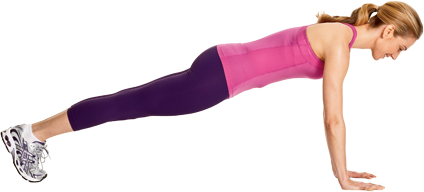

Step 1: Stand straight with your feet and legs together, hands on your hips. Lunge forward with your left foot, then push back to standing.
Step 2: Perform a side lunge by planting your left foot out to your left side, then push back to standing.
Step 3: Extend your left leg behind you, and lower yourself into a reverse lunge, then push back to standing.
Repeat: Perform the drill with your right leg; continue alternating legs for one minute.



4. SCISSOR JUMPS
Step 1: Stand with your right foot in front of your left, spaced about 2 feet apart. Extend your right arm behind you and your left arm in front of you, elbows comfortably bent about 90 degrees.
Step 2: Quickly jump up and switch arm and leg positions while in the air, so that you land with your left foot in front of your right foot, your right arm in front of your body, and your left arm behind you.
Repeat: Continue jumping and alternating legs for one minute.

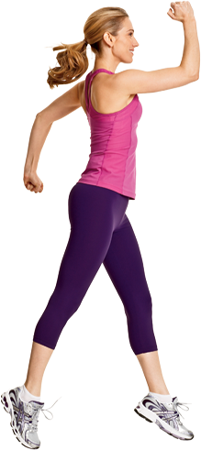
5. CROSS-PUNCH KICKS
Step 1: Stand with your feet about hip-width apart, right foot in front of left foot. Hold fisted hands in front of your face, palms facing each other. Quickly throw a left punch in front of your body at chest level, pull back, then throw a right punch and pull back.
Step 2: Next, kick your left leg forward about waist-high, then lower it back to the floor. Jump and switch your stance—left foot in front of right foot—and perform again, this time throwing a right punch, a left punch, then kicking forward with your right leg.
Repeat: Alternate for one minute.


EXPERT TIP: Adopt Healthy Hobbies

“Lots of hobbies can be physically active and not feel like typical exercise. You don’t have to be a trained dancer to dance—you just dance! You can dance in your room alone or join a local drop-in class. In recent years, Bollywood and belly dancing have increased in popularity. Maybe you like nature. Pick up bird-watching or hiking.”
—Rebecca Scritchfield, MA, RD, blogger, Rebecca Thinks
IF YOU’RE DOING CARDIO AT LEAST THREE TIMES A WEEK, you need enough daily carbs to fuel your workouts and replenish your energy stores. Remember: All carbs are not created equal, which means empty calories such as a candy bar won’t cut it. The best carbs to choose are ones that contribute plenty of other nutrients such as protein, vitamins, fiber, and antioxidants, like these five below:

RAISIN AND ALMOND MIX
Raisins are rich in energy-boosting carbs as well as potassium, which maintains fluid balance and thus helps prevent dehydration as well as muscle cramps. Almonds are a top source of antioxidants, which protect against harmful free radicals your body produces during intense exercise. Cyclists who ate 60 almonds a day before meals for four weeks boosted their antioxidant capacity and increased their trial time distance, according to a study presented at the 2009 annual meeting of the American College of Sports Medicine.
LOW-FAT RICOTTA WITH HONEY
After a tough workout, your muscles are hungry for protein to help them repair and rebuild. Whey protein, used to make ricotta cheese, is a top pick. Whey is rich in B-lactoglobulin, a protein that’s especially effective in stimulating muscle resynthesis, according to a 2010 Nutrition & Metabolism study. Adding some quickly digested carbs—like a drizzle of honey—to this post-exercise snack encourages your muscles to soak up that protein even faster.
GINGER SMOOTHIE
Does your workout leave you aching? Instead of heading to the medicine cabinet for a couple of aspirin, make a beeline to the kitchen for some ginger. According to a 2010 Journal of Pain study this potent anti-inflammatory root eases post-exercise muscle pain. It’s also been shown to reduce joint stiffness and swelling, too. You can throw some fresh ginger into your favorite smoothie, or try the Carrot, Apple, and Ginger Refresher as a post-workout snack.
WHOLE-GRAIN CEREAL AND MILK
It may sound boring, but it’s anything but: In fact, a bowl of whole-grain cereal and milk was found to be just as good as a sports drink for recovery after exercise by researchers at the University of Texas at Austin.
ENERGY BAR
Nothing beats an energy bar for convenience. But set the “bar” high: Look for one with at least 3 grams of protein and fiber and less than 20 grams of sugar. We like Luna and Zing bars, which have 10 and 13 grams of protein, respectively, to give you a nice post-workout boost.


“Cardio is boring, so I just can’t make myself do it.”
PHILLIP RHODES
Cooking Light Executive Managing Editor
 GET MOVING CHALLENGE: Phillip doesn’t have an exercise problem—he has a cardio problem: “I don’t like getting on the treadmill or elliptical—you just go and go and go and nothing happens. I find it boring.” He’s a dedicated gym-goer, though, three to four times a week, focusing on weights. But Phillip wants to stop the pant-size progression, which means more cardio.
GET MOVING CHALLENGE: Phillip doesn’t have an exercise problem—he has a cardio problem: “I don’t like getting on the treadmill or elliptical—you just go and go and go and nothing happens. I find it boring.” He’s a dedicated gym-goer, though, three to four times a week, focusing on weights. But Phillip wants to stop the pant-size progression, which means more cardio.
OUR ADVICE
▪ Mix it up. A cardio program with some tricks—like intervals—will keep his muscles as intrigued as his brain, will intensify his workouts, and should help to evoke a more calorically intense response from his body. See our cardio blast workout for more details.
▪ Set up workout dates. If there’s something that doesn’t feel like work—say, tennis or racquetball, which introduce the buddy benefit—rein in a friend fora twice-or thrice-weekly game.
▪ Take it outdoors. As an Alabama resident, Philliphas many months of outdoor-fitness weather. One of the biggest reasons most people prefer to exercise outdoors is that it always feels different.
▪ Count the seconds. Researchers at the University of New South Wales found that people who exercised at a high intensity for 8 seconds, then at a low intensity for 12 seconds, lost three times more fat in 20 minutes than exercisers who worked out at a constant pace for 40 minutes. It’s hard to do this for a full 20 minutes, but boy, does it focus the brain.
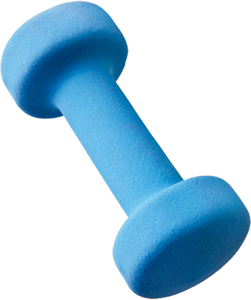

If you’re easily bored, sign up for a short-term cardio activity that lasts three months or less, like a 12-week spin class or training to run a 5K.
Prepare a Pre-Workout Smoothie
WHEN IT COMES TO A PRE-OR POST-WORKOUT SNACK, smoothies are a hands-down winner. Yogurt or milk adds protein and some calcium, while fruit contributes natural sweetness and vitamin C for tired, sore muscles. Drink these smoothies about an hour before a cardio session to fuel your workout, or within the ideal recovery window—between 30 and 60 minutes after exercise—when your body is best able to repair itself and replenish the energy you’ve spent.
½ cup 1% low-fat milk
½ cup crushed ice
1 tablespoon honey
⅛ teaspoon ground nutmeg
1 large sliced ripe banana, frozen
1 cup plain 2% reduced-fat Greek yogurt
1. Place first 5 ingredients in a blender; process 2 minutes or until smooth. Add yogurt; process just until blended. Serve immediately. Serves 2 (serving size: 1 cup).
CALORIES 212; FAT 3.6g (sat 2.5g, mono 0.2g; poly 0.1g); PROTEIN 14.2g; CARB 34.2g; FIBER 2g; CHOL 9mg; IRON 0.3mg; SODIUM 75mg; CALC 200mg
Strawberry-Guava Smoothie
1 cup quartered strawberries (about 5 ounces)
½ cup guava nectar
1 (6-ounce) carton organic strawberry fat-free yogurt
1 small sliced ripe banana, frozen
5 ice cubes (about 2 ounces)
1. Place all ingredients in a blender; process 2 minutes or until smooth. Serve immediately. Serves 2 (serving size: about 1¼ cups).
CALORIES 156; FAT 0.5g (sat 0.1g, mono 0.1g, poly 0.2g); PROTEIN 4.2g; CARB 36.2g; FIBER 3.6g; CHOL 2mg; IRON 0.5mg; SODIUM 49mg; CALC 116mg
Peach-Mango Smoothie
⅔ cup frozen sliced peaches
⅔ cup frozen mango pieces
⅔ cup peach nectar
1 tablespoon honey
1 (6-ounce) carton organic peach fat-free yogurt
1. Place all ingredients in a blender; process 2 minutes or until smooth. Serve immediately. Serves 2 (serving size: 1 cup).
CALORIES 184; FAT 0.3g (sat 0.1g; mono 0.1g; poly 0.1g); PROTEIN 4.1g; CARB 44g; FIBER 2.4g; CHOL 2mg; IRON 0.4mg; SODIUM 50mg; CALC 107mg
Carrot, Apple, and Ginger Refresher
½ cup 100% carrot juice, chilled
½ cup unsweetened applesauce
½ cup organic vanilla fat-free yogurt
1 teaspoon fresh lemon juice
½ teaspoon grated peeled fresh ginger
1 sliced ripe banana, frozen
5 ice cubes (about 2 ounces)
1. Place all ingredients in a blender; process 2 minutes or until smooth. Serve immediately. Serves 2 (serving size: about 1¼ cups).
CALORIES 138; FAT 0.1g (sat 0g; mono 0g; poly 0.1g); PROTEIN 4.3g; CARB 32.7g; FIBER 2.3g; CHOL 2mg; IRON 0.3mg; SODIUM 79mg; CALC 126mg
A 2010 Journal of Pain study found that ginger, a potent anti-inflammatory, eases post-exercise muscle pain.
CLOCKWISE FROM TOP LEFT: Banana Breakfast Smoothie; Carrot, Apple, and Ginger Refresher; Strawberry-Guava Smoothie; and Peach-Mango Smoothie
PASTA IS A HEARTY MEAL that provides easy-to-digest carbs that can power you through your next race or workout. Add in some lean protein like shrimp or pork if you’re looking to help repair muscles and refuel your tank after exercise. Toss in your favorite fresh vegetables for texture, color, extra vitamins, and fiber.
Mini Farfalle with Roasted Peppers, Onions, Feta, and Mint

8 ounces uncooked mini farfalle (bow tie pasta)
¼ cup pine nuts
1 tablespoon extra-virgin olive oil
1 cup prechopped onion
¼ cup golden raisins
1 tablespoon minced garlic
1 cup sliced bottled roasted red bell peppers, rinsed and drained
1 cup (4 ounces) crumbled feta cheese
2 tablespoons chopped fresh mint
2 tablespoons chopped fresh basil
¼ teaspoon black pepper
1. Cook pasta according to package directions, omitting salt and fat. Drain pasta over a bowl; reserve ½ cup cooking liquid.
2. While pasta cooks, heat a small nonstick skillet over medium heat. Add nuts; cook 4 minutes or until golden brown, stirring frequently.
3. Heat a large skillet over medium heat. Add oil; swirl to coat. Add onion, raisins, and garlic; cook 8 minutes or until onion begins to brown, stirring frequently. Add bell peppers; cook 4 minutes or until heated, stirring occasionally. Add pasta and ½ cup reserved cooking liquid; cook 1 minute, stirring to combine. Remove from heat; stir in feta, mint, basil, and black pepper. Sprinkle with nuts. Serves 4 (serving size: about 1½ cups pasta and 1 tablespoon nuts).
CALORIES 453; FAT 17.4g (sat 5.1g; mono 4.1g; poly 3.3g); PROTEIN 16.6g; CARB 59.7g; FIBER 4.2g; CHOL 25mg; IRON 3.5mg; SODIUM 558mg; CALC 131mg
Creamy Linguine with Shrimp and Veggies
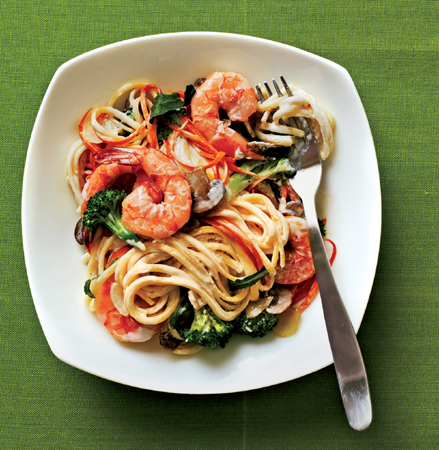
6 quarts water
1 teaspoon salt, divided
8 ounces uncooked linguine
3 cups small broccoli florets
1½ tablespoons butter
1 cup chopped onion
8 ounces sliced mushrooms
2 garlic cloves, minced
12 ounces peeled and deveined medium shrimp
1 julienne-cut carrot
¾ cup (6 ounces) ⅓ -less-fat cream cheese
¼ teaspoon ground black pepper
1. Bring 6 quarts water to a boil in a saucepan. Add ½ teaspoon salt and pasta; cook 5 minutes. Add broccoli; cook 3 minutes or until pasta is al dente. Drain through a sieve over a bowl, reserving ½ cup pasta water.
2. Melt butter in a Dutch oven over medium-high heat. Add onion and mushrooms to pan; sauté 5 minutes, stirring occasionally. Add garlic; sauté 1 minute, stirring constantly. Add remaining ½ teaspoon salt, shrimp, and carrot; sauté 3 minutes, stirring occasionally. Add pasta mixture, ½ cup reserved pasta water, cream cheese, and pepper to pan; cook 3 minutes or until cheese melts and shrimp are done, stirring occasionally. Serves 4 (serving size: 2 cups).
CALORIES 501; FAT 16.3g (sat 9.4g, mono 3.9g, poly 1.2g); PROTEIN 32.2g; CARB 57g; FIBER 5.6g; CHOL 171mg; IRON 4.8mg; SODIUM 691mg; CALC 136mg
HOW TO COOK PASTA
To make great pasta, cook it al dente, or “to the tooth.” That means the pasta will be tender and not raw-tasting, but you’ll get a slight resistance when you bite. With long pastas like spaghetti and linguine, you can tell that it has been cooked al dente if there is a dot of white at the center. For tube-shaped pasta, such as penne and ziti, look for a faint but clear ring of white around the center of the pasta. If you’re going to simmer cooked pasta with a sauce, cook the pasta slightly less than al dente—it will finish cooking in the sauce.
IF YOU’RE SQUEEZING FITNESS into your lunch hour, nothing beats a salad topped with lean protein for a post-workout meal. Studies show that a protein-carb combo enhances muscle recovery after exercise more effectively than carbs alone. It’ll also keep you full, so you’re less tempted to snack later.
Edamame Salad with Crisp Steak Bits

3 cups frozen shelled edamame (green soybeans)
2 tablespoons lower-sodium soy sauce
1 tablespoon minced peeled fresh ginger
1 tablespoon mayonnaise
1 tablespoon Dijon mustard
2 teaspoons rice wine vinegar
1 teaspoon dark sesame oil
1 pint cherry tomatoes, quartered
1½ cups sliced seeded English cucumber (about 1)
4 green onions, chopped
1 tablespoon olive oil
8 ounces flank steak, cut into small pieces
¼ teaspoon kosher salt
¼ teaspoon freshly ground black pepper
1. Cook edamame according to package directions; drain. Rinse with cold water; drain.
2. Combine soy sauce and next 5 ingredients in a large bowl, stirring with a whisk. Add edamame, tomatoes, cucumber, and onions; toss to coat.
3. Heat a medium cast-iron skillet over high heat. Add olive oil to pan; swirl to coat. Sprinkle steak with salt and pepper. Add to pan; cook 5 minutes or until well browned and crisp, stirring frequently. Spoon 1½ cups edamame mixture onto each of 4 plates; top evenly with steak. Serves 4.
CALORIES 277; FAT 14.8g (sat 2.7g, mono 6.7g, poly 2.8g); PROTEIN 23.1g; CARB 14.6g; FIBER 6.1g; CHOL 20mg; IRON 3.5mg; SODIUM 540mg; CALC 97mg
Shrimp Cobb Salad

4 center-cut bacon slices
1 pound large shrimp, peeled and deveined
½ teaspoon paprika
¼ teaspoon black pepper
Cooking spray
¼ teaspoon salt, divided
2½ tablespoons fresh lemon juice
1½ tablespoons extra-virgin olive oil
½ teaspoon whole-grain Dijon mustard
1 (10-ounce) package romaine salad
2 cups cherry tomatoes, quartered
1 cup shredded carrot (about 2 carrots)
1 cup frozen whole-kernel corn, thawed
1 ripe peeled avocado, cut into 8 wedges
1. Cook bacon in a large skillet over medium heat until crisp. Remove bacon from pan; cut in half crosswise. Wipe pan clean with paper towels. Increase heat to medium-high. Sprinkle shrimp with paprika and pepper. Coat pan with cooking spray. Add shrimp to pan; cook 2 minutes on each side or until done. Sprinkle with ⅛ teaspoon salt; toss to coat.
2. While shrimp cooks, combine remaining ⅛ teaspoon salt, juice, oil, and mustard in a large bowl, stirring with a whisk. Add lettuce; toss to coat.
3. Arrange about 1½ cups lettuce mixture on each of 4 plates. Top each serving with about 6 shrimp, ½ cup tomatoes, ¼ cup carrot, ¼ cup corn, 2 avocado wedges, and 2 bacon pieces. Serves 4.
CALORIES 332; FAT 15.2g (sat 2.9g, mono 8g, poly 2.6g); PROTEIN 30g; CARB 21.8g; FIBER 7.5g; CHOL 181mg; IRON 4.3mg; SODIUM 551mg; CALC 110mg
EXPERT TIP: Give Exercise Meaning

“Find ways to make your exercise have purpose and meaning, such as riding your bike to work, walking the dog, or running with your friends. You’ll be more likely to stick with it and won’t view it as punishment.”
—Nancy Clark, MS, RD sports nutritionist, author of Nancy Clark’s Sports Nutrition Guidebook
Studies show that people are more likely to make exercise a habit if they choose a simple cue or trigger to get them started, such as lacing up their shoes before breakfast or running as soon as they get home from work.
YOU CAN’T GO WRONG with a sandwich after a workout—it’s got everything in a hand-held package and provides just the right balance of protein and carbs. Throw in some antioxidant-rich fresh veggies such as lettuce and tomatoes to further help your muscles repair. You can easily use 100% whole-wheat bread to boost fiber content and get a whole-grain serving (another 12HH challenge).
Herbed Chicken Salad Sandwiches

3 tablespoons canola mayonnaise
3 tablespoons plain 2% reduced-fat Greek yogurt
1 tablespoon finely chopped fresh tarragon
1 tablespoon fresh lemon juice
⅛ teaspoon kosher salt
2 cups chopped skinless, boneless rotisserie chicken breast
¼ cup minced sweet onion
8 (1½-ounce) slices rye sandwich bread
4 red leaf lettuce leaves
1 cup microgreens or arugula
1. Combine first 5 ingredients in a large bowl. Stir in chicken and onion. Top each of 4 bread slices with 1 lettuce leaf, about ½ packed cup chicken salad, ¼ cup microgreens, and 1 bread slice. Serves 4 (serving size: 1 sandwich).
CALORIES 382; FAT 9g (sat 1.4g, mono 3.9g, poly 2.4g); PROTEIN 30.2g; CARB 42.9g; FIBER 5.1g; CHOL 60mg; IRON 3.2mg; SODIUM 745mg; CALC 89mg
The American College of Sports Medicine recommends refueling muscles with 30 to 60 grams of carbohydrate in the first 30 minutes after an hour-long workout.
Tuscan Tuna Sandwiches
¼ cup finely chopped fennel bulb
¼ cup chopped red onion
¼ cup chopped fresh basil
2 tablespoons drained capers
2 tablespoons fresh lemon juice
2 tablespoons extra-virgin olive oil
¼ teaspoon black pepper
2 (6-ounce) cans solid white tuna in water, drained
1 (4-ounce) jar chopped roasted red bell peppers, drained
8 (1-ounce) slices 100% whole-wheat bread, toasted
1. Combine first 9 ingredients in a bowl, stirring well. Spoon ½ cup tuna mixture on each of 4 bread slices. Top each serving with 1 bread slice. Cut each sandwich in half. Serves 4 (serving size: 1 sandwich).
CALORIES 307; FAT 11.1g (sat 2g, mono 6.9g, poly 1.8g); PROTEIN 24.5g; CARB 26.5g; FIBER 4.4g; CHOL 30mg; IRON 2.3mg; SODIUM 726mg; CALC 83mg

IF YOU’RE PACKING this for lunch, store the topping and hummus in separate containers.
4 (1½-ounce) slices sourdough bread
1½ cups quartered grape tomatoes
⅓ cup chopped green onions
¼ cup sliced pitted kalamata olives
1 tablespoon olive oil
¼ teaspoon black pepper
⅛ teaspoon kosher salt
1 garlic clove, minced
1 (8-ounce) container plain hummus
½ cup (2 ounces) crumbled goat cheese
1. Preheat broiler.
2. Arrange bread on a baking sheet. Broil 1 minute or until toasted.
3. Combine tomatoes and next 6 ingredients. Spread about ¼ cup hummus over each bread slice. Divide tomato mixture evenly among servings. Top each serving with 2 tablespoons cheese. Serves 4 (serving size: 1 sandwich).
CALORIES 358; FAT 20.1g (sat 3.1g, mono 11.9g, poly 3.9g); PROTEIN 12.3g; CARB 36.5g; FIBER 4.3g; CHOL 7mg; IRON 3.5mg; SODIUM 811mg; CALC 100mg
 What are your tricks for staying active?
What are your tricks for staying active?
@Claire_Atwell: Going for a run before work in the morning! Get your cardio in before 9 a.m. and stay energized all day!
@ElizabethAFloyd: My healthy habits are walking or biking everywhere because I don’t own a car! Well, or the bus! But I do go to the gym two times a week.